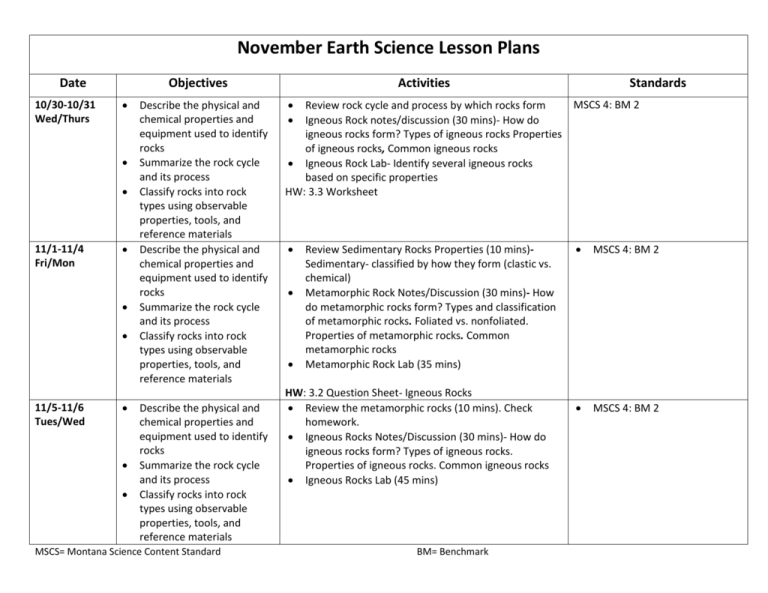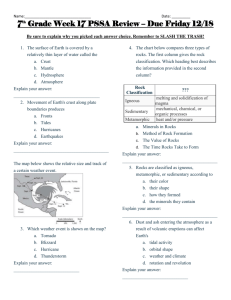November Earth Science Lesson Plans Date Objectives Activities
advertisement

November Earth Science Lesson Plans Date 10/30-10/31 Wed/Thurs Objectives 11/1-11/4 Fri/Mon 11/5-11/6 Tues/Wed Describe the physical and chemical properties and equipment used to identify rocks Summarize the rock cycle and its process Classify rocks into rock types using observable properties, tools, and reference materials Describe the physical and chemical properties and equipment used to identify rocks Summarize the rock cycle and its process Classify rocks into rock types using observable properties, tools, and reference materials Describe the physical and chemical properties and equipment used to identify rocks Summarize the rock cycle and its process Classify rocks into rock types using observable properties, tools, and reference materials MSCS= Montana Science Content Standard Activities Standards MSCS 4: BM 2 Review rock cycle and process by which rocks form Igneous Rock notes/discussion (30 mins)- How do igneous rocks form? Types of igneous rocks Properties of igneous rocks, Common igneous rocks Igneous Rock Lab- Identify several igneous rocks based on specific properties HW: 3.3 Worksheet Review Sedimentary Rocks Properties (10 mins)Sedimentary- classified by how they form (clastic vs. chemical) Metamorphic Rock Notes/Discussion (30 mins)- How do metamorphic rocks form? Types and classification of metamorphic rocks. Foliated vs. nonfoliated. Properties of metamorphic rocks. Common metamorphic rocks Metamorphic Rock Lab (35 mins) HW: 3.2 Question Sheet- Igneous Rocks Review the metamorphic rocks (10 mins). Check homework. Igneous Rocks Notes/Discussion (30 mins)- How do igneous rocks form? Types of igneous rocks. Properties of igneous rocks. Common igneous rocks Igneous Rocks Lab (45 mins) BM= Benchmark MSCS 4: BM 2 MSCS 4: BM 2 11/7-11/8 Thur/Fri 11/11-11/12 Mon/Tues 11/13-11/14 Wed/Thurs 11/18-11/19 Mon/Tues Describe the physical and chemical properties and equipment used to identify rocks Summarize the rock cycle and its process Classify rocks into rock types using observable properties, tools, and reference materials Rock Poster (75 mins)- Create an informational poster on one of the following rocks subjects: Rock Cycle (draw cycle, give examples of each type of rock). Metamorphic Rocks (how they form, types, examples, foliated vs. nonfoliated). Sedimentary Rocks (how they form, types, examples, clastic vs. chem.). Igneous Rocks (how they form, types, examples, texture and compositions). Hand out test review HW: Test Next Class MSCS 4: BM 2 Explain how the water cycle circulates Earth’s water supply in an unending cycle. Explain how the water cycle is kept in balance Rocks Test (45 mins) Read 6.1 and complete question sheet (20 mins) Discuss water cycle and 6.1 worksheet (10 mins) HW: Finish 6.1 for homework MSCS 4: BM 4 Explain how the water cycle circulates Earth’s water supply in an unending cycle. Explain how the water cycle is kept in balance What is a cycle? Notes (30 mins)- Water on Earth. Diagram the water cycle. Streamflow- velocity, gradient, channel characteristics, discharge, tributaries, base level, meanders Begin Watershed Activity (45 mins) MSCS 4: BM 4 Explain how streams erode their channels and transport sediments Discuss how stream deposition occurs Identify the features of a watershed Review: water cycle and stream flow (15 mins) Finish Watershed Lab (45 mins). Design and Build an Island Watershed. Lab worksheet HW: Read 6.2 and complete question sheet (20 mins) MSCS 4: BM 4 MSCS= Montana Science Content Standard BM= Benchmark 11/20-11/21 Wed/Thurs 11/22-11/25 Fri/Mon 11/26-12/2 Tues/Mon Explain how streams erode their channels and transport sediments Discuss how stream deposition occurs Identify the features of a watershed Describe the location and movement of groundwater Discuss environmental threats to water supplies Discuss the different types of glaciers and where each glacier is found Describe how glaciers move and differentiate between the different types of glaciers Identify the landscape features that glaciers form Discuss the different types of glaciers and where each glacier is found Describe how glaciers move and differentiate between the different types of glaciers Identify the landscape features that glaciers form MSCS= Montana Science Content Standard Review: water cycle and stream flow (20 mins). Island Watershed- tributaries, watershed, divides, mouth, headwaters. Label worksheet Water Notes: The Work of Streams: Watersheds, Weathering, Erosion, and Deposition of sediments (35 mins) Erosion, sediment transport (dissolved load, suspended load, bed load). Deposition- deltas, natural levees. Stream Valleys Groundwater- Clark Fork River Restoration Project Reading (20 mins) Discuss- Groundwater Contamination HW: Read 6.3 and complete worksheet- Groundwater Review and discuss water cycle, running water, and ground water Water Quiz Read 7.1 and complete question sheet Check question sheet and Discuss 7.1 Glacier Notes: Types of glaciers, how glaciers move, glacier erosion, landforms created by glaciers Glacier Pictures: Identify each type of landform How the Ice Age Impacted Montana- Glacial Lake Missoula- Discussion and pictures (15 mins) Glacial Lake Missoula Ice Dam Demonstration (15 mins)- 2-liter bottle and ice BM= Benchmark MSCS 4: BM 4 MSCS 4: BM 4 MSCS 4: BM 4 12/3-12/4 Tues/Wed Identify the landscape features formed by glaciers Explore how Montana was impacted by the last ice age MSCS= Montana Science Content Standard Review glacial features (10 mins) Laptop use and directions(10 mins) Virtual Field Trip: “How the Ice Age Helped Shape Montana” (60 mins)- Follow the directions on the worksheet to visit several websites and answer questions about glaciers and Montana’s landscape BM= Benchmark MSCS 4: BM 4








